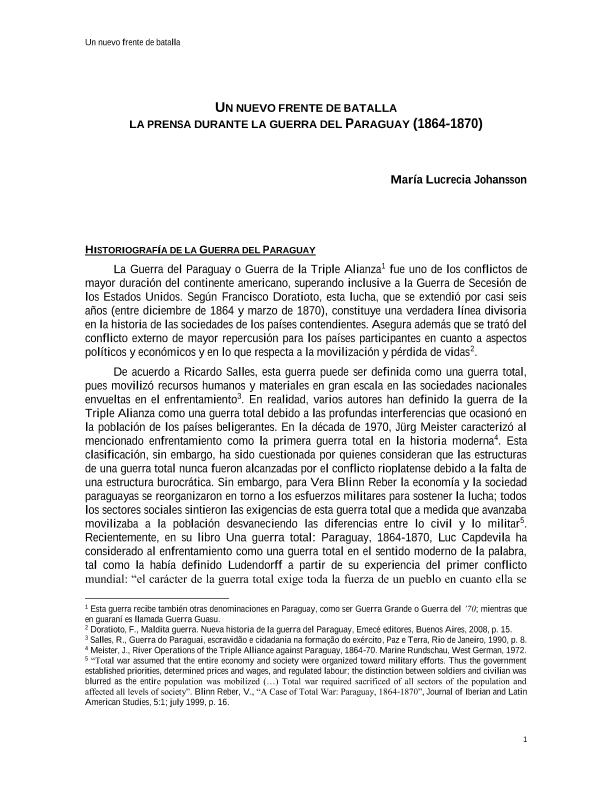Mostrar el registro sencillo del ítem
dc.contributor.author
Johansson, Maria Lucrecia

dc.date.available
2018-08-29T22:15:44Z
dc.date.issued
2012-12
dc.identifier.citation
Johansson, Maria Lucrecia; Un nuevo frente de batalla: la prensa durante la guerra del Paraguay (1864-1870); Universidad Católica Nuestra Señora de la Asunción. Centro de Estudios Antropológicos; Suplemento Antropológico; 47; 2; 12-2012; 111-186
dc.identifier.issn
0378-9896
dc.identifier.uri
http://hdl.handle.net/11336/57625
dc.description.abstract
El artículo aborda los vínculos existentes entre actividad periodística, propaganda política y conflicto bélico en Paraguay durante la Guerra de la Triple Alianza. Esta guerra está calificada como guerra total, porque movilizó recursos humanos y materiales en gran escala en las sociedades nacionales envueltas en el enfrentamiento. La actividad periodística en esta época se caracterizó por la aparición de periódicos ilustrados que tuvieron como objetivo central la “construcción de identidades”, mediante imágenes que denigraban a las tropas aliadas y que aludían a la valentía, honor e ingenio de las tropas paraguayas y de su conductor el Mariscal López. Esta actividad periodística respondía a las sátiras y descalificaciones del conductor López de parte de la prensa brasilera y argentina. El gobierno paraguayo puso en marcha una revolución periodística, constituida por la creación de cuatro periódicos de trinchera. La revolución periodística fue más allá de la modificación de las tecnologías y contenidos de los periódicos. Se aprecia el fenómeno de la prensa guaraní como elemento propio y estratégico durante la guerra; así nace la literatura en esta lengua y con los periódicos ilustrados se desarrolló una iconografía de rasgos novedosos que se divorció de los modelos importados de Europa.
dc.description.abstract
The article discusses the links between journalistic, political propaganda and warfare in Paraguay during the war of the Triple Alliance. This war is qualified as a total war because it mobilized human and physical resources on a large scale in national societies involved in the confrontation. Journalistic activity during this period was characterized by the appearance of illustrated newspapers that had as main objective the “construction of identities”, through images that denigrate the Allied troops and which alluded to the courage, honor and ingenuity of the Paraguayan troops and its leader the Mariscal López. This journalistic activity answered satires and disqualifications of leader Lopez on the part of the Brazilian and Argentine media. The Paraguayan Government launched a journalistic revolution, consisting of the creation of four trench’s newspapers. The journalistic revolution went beyond the modification of technologies and content of newspapers. The phenomenon of the press can be seen in Guarani as own strategic wartime giving birth to literature in this language and with the newspapers illustrated developed an iconography of novel traits that divorced from models imported from Europe. Journalistic activity during this period was characterized by the appearance of illustrated newspapers that had as main objective the “construction of identities”, through images that denigrate the Allied troops and which alluded to the courage, honor and ingenuity of the Paraguayan troops and its leader the Mariscal López. This journalistic activity answered satires and disqualifications of leader Lopez on the part of the Brazilian and Argentine media. The Paraguayan Government launched a journalistic revolution, consisting of the creation of four trench’s newspapers. The journalistic revolution went beyond the modification of technologies and content of newspapers. The phenomenon of the press can be seen in Guarani as own strategic wartime giving birth to literature in this language and with the newspapers illustrated developed an iconography of novel traits that divorced from models imported from Europe.
dc.format
application/pdf
dc.language.iso
spa
dc.publisher
Universidad Católica Nuestra Señora de la Asunción. Centro de Estudios Antropológicos
dc.rights
info:eu-repo/semantics/openAccess
dc.rights.uri
https://creativecommons.org/licenses/by-nc-sa/2.5/ar/
dc.subject
Prensa
dc.subject
Guerra
dc.subject
Paraguay
dc.subject
Propaganda
dc.subject.classification
Historia

dc.subject.classification
Historia y Arqueología

dc.subject.classification
HUMANIDADES

dc.title
Un nuevo frente de batalla: la prensa durante la guerra del Paraguay (1864-1870)
dc.type
info:eu-repo/semantics/article
dc.type
info:ar-repo/semantics/artículo
dc.type
info:eu-repo/semantics/publishedVersion
dc.date.updated
2018-08-21T14:02:41Z
dc.journal.volume
47
dc.journal.number
2
dc.journal.pagination
111-186
dc.journal.pais
Paraguay

dc.journal.ciudad
Asunción
dc.description.fil
Fil: Johansson, Maria Lucrecia. Consejo Nacional de Investigaciones Científicas y Técnicas. Centro Científico Tecnológico Conicet - Tucumán. Instituto Superior de Estudios Sociales. Universidad Nacional de Tucumán. Instituto Superior de Estudios Sociales; Argentina
dc.journal.title
Suplemento Antropológico

dc.relation.alternativeid
info:eu-repo/semantics/altIdentifier/url/https://dialnet.unirioja.es/servlet/articulo?codigo=6441673
dc.relation.alternativeid
info:eu-repo/semantics/altIdentifier/url/http://www.sicpy.gov.py/busquedas/index.php?categorias-111=&page=3
Archivos asociados
